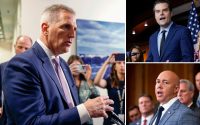Biden says ‘no’ to F-16 fighter jets for Ukraine
President Biden on Monday flatly ruled out providing F-16 fighter jets to Ukraine in its war against Russia, even as Moscow has stepped up its attacks to try to break Kyiv’s resolve.
When asked at the White House about whether the US would send the warplanes, Biden told reporters, “No.”
Ukraine has been pressing its Western allies to supply fourth-generation fighter planes, after securing pledges from the US and Germany last week to send modern battle tanks after months of tough negotiations.
A Ukrainian air force spokesman previously said it would take its pilots about six months to train on fighter jets such as the F-16, which also pose significant logistical challenges related to maintenance.
The unequivocal refusal from the president came just days after Biden’s deputy national security adviser, Jon Finer, said in an MSNBC interview that the US would discuss fighter jets “very carefully” with Ukraine and allies.

John Kirby, US national security council coordinator for strategic communications, later defended Biden’s stance on F-16s by pointing out that Washington was already providing billions of dollars worth of weapons to Ukraine.
“What I can tell you is that there’s a lot of capability that is being sent, and will be sent in the coming weeks and months,” Kirby told CNN. “The kinds of capabilities that we know will be critical to helping Ukrainians again in the fighting now in the wintertime, as well as the kind of fighting that we expect that they’re going to be doing in the spring.”
Ukraine’s stepped-up lobbying for fighter jets has put a strain on the unity of its allies in the West, some of whom are concerned that the move could escalate and broaden the bloody conflict, approaching its one-year mark.

Kyiv has repeatedly appealed to allies to send jets, arguing that they are required to challenge Russia’s air superiority and to ensure the success of its anticipated spring counteroffensives.
Ukrainian Defense Minister Oleksii Reznikov was due Tuesday in Paris, where discussions about the possible delivery of fighter jets to Ukraine were expected to be on the table.
German Chancellor Olaf Scholz appeared to balk at the prospect of providing fighter jets, suggesting Sunday that the reason for the entire discussion might be down to “domestic political motives” in some countries.
Dutch Prime Minister Mark Rutte said Monday there are “no taboos” in efforts to help Ukraine — but he cautioned that sending jets “would be a very big next step.”
French President Emmanuel Macron said Monday that France doesn’t rule out sending fighter jets to Ukraine, but he laid out multiple conditions before such a significant step is taken.
The conditions, he said, include not leading to an escalation of tensions or using the aircraft “to touch Russian soil,” and not resulting in weakening “the capacities of the French army.”

He also said Ukraine must also formally request the planes — something that could happen when Reznikov sits down for talks in Paris.
As in previous talks about how to help Ukraine, Poland is a leading advocate in the European Union for providing military aid. Poland, Slovakia and the Baltic countries on NATO’s eastern flank feel especially threatened by Russia.
NATO member Croatia’s president, meanwhile, criticized Western nations for supplying Ukraine with tanks and other weapons, with President Zoran Milanovic arguing that that aid will only prolong the war.

In the first weeks of the conflict, discussions focused on the possibility of providing Kyiv with Soviet-made MiG-29 fighter jets that Ukrainian pilots are familiar with. But in March, the Pentagon shut down Poland’s proposal to transfer its MiG-29 fighter jets to Kyiv through a US base in Germany, citing a high risk of triggering a Russia-NATO escalation.
Ukraine inherited a large fleet of Soviet-made warplanes, including Su-27 and MiG-29 fighter jets and Su-25 ground attack aircraft.
Russia methodically targeted Ukrainian air bases and air defense batteries in the opening stage of the conflict, but Ukraine has been smart about relocating its warplanes and concealing air defense assets, resulting in Russia’s failure to gain full control of the skies.
After suffering heavy losses early during the conflict, the Russian air force has avoided venturing deep into Ukraine’s airspace and mostly focused on close support missions along the front line.
The Ukrainian air force faced similar challenges, trying to save its remaining warplanes from being hit by Russian fighter jets and air defense systems.
Ukrainian President Volodymyr Zelensky said this week that Russia had begun retaliating for Ukraine’s resistance to its invasion with relentless attacks in the east.
“I think that Russia really wants its big revenge. I think they have started it,” Zelensky told reporters during a trip to the city of Odessa in the south.
Zelensky is urging the West to hasten the delivery of its promised weapons, including the Abrams tanks from the US and the Leoprad 2 tanks from Germany, so that Ukraine can go on the offensive after a prolonged stalemate.
The US-based think tank Institute for the Study of War said “the West’s failure to provide the necessary materiel” last year was the main reason Kyiv’s advances had halted since November.
With Post wires


